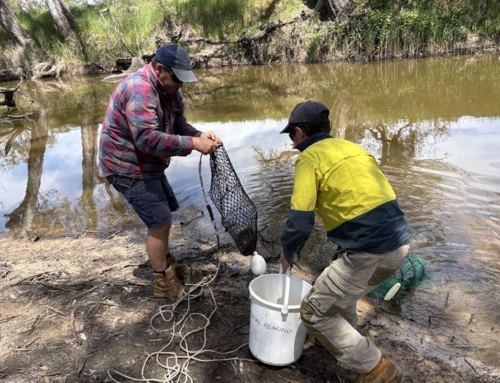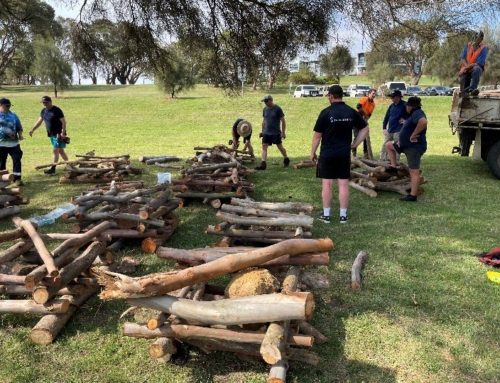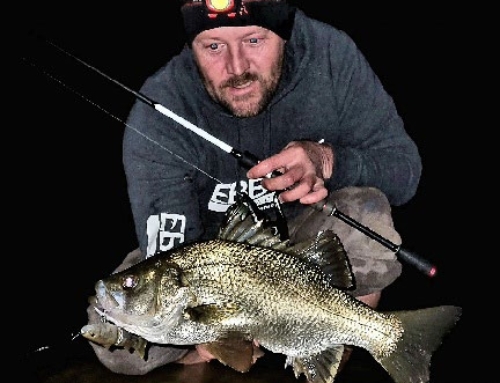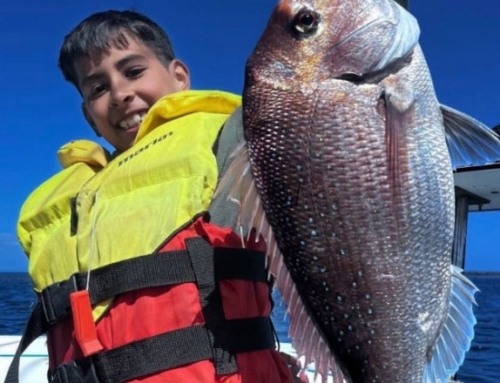Late each spring yellowtail kingfish turn up along the Victorian coastline, usually when the water temperature rises in excess of 16 degrees. Scott Gray explains how to target these mighty pelagics.
Each year the dawning of spring and the rising temperatures bring new hopes about how good the coming season will be and wonderment about where the fish are likely to turn up next. Over the past 15 years or so that I’ve fished in Southwest Victoria, I’ve been presented with new challenges and new locations to truly test my skills (and patience) on these sometimes elusive predators.
Fishing my regular haunts like Portland’s north shore, Port Fairy and Killarney have usually ended up producing good quality fish with some persistence, but last season was to be an eye opener. By late December, the kings had failed to show up at most of their regular hunting grounds, leaving many of my fellow anglers wondering just where the fish had gone. This was compounded by the disappointment of a reasonably quiet 2011/2012 summer where the larger fish weren’t in abundance inshore.
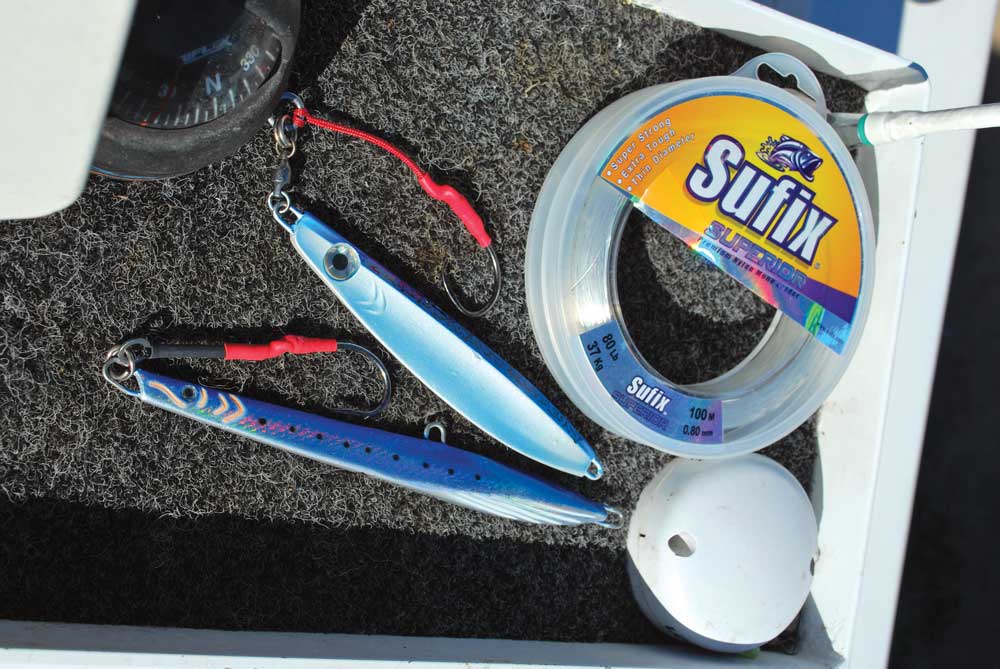
I usually rig two different kinds of jigs a flutter style (left) and knife jig.
I realised if the fish weren’t on the coast then they had to be somewhere, so I spent more time fishing offshore, relentlessly searching for them. Patience it seems does pay off and I will never forget my day on January 11th 2013. I was out trolling approximately 15 km offshore on some thick bait schools when I was lucky enough to see a phenomenon many of the local old timers used to talk about. The bait was stacked up thick on the surface, shimmering in the morning sun. The sea breeze had just come in, but the sea was still soft and glassy. Seemingly out of nowhere, a few hungry terns arrived and proceeded to descend on the bait, then a few more, then a flock of bigger gannets. It was reminiscent of what one would see during the Tuna season. The birds moved away quickly so we followed and without taking much notice we found ourselves several kilometres south from Julia Percy Island out in the middle of nowhere. Then it happened, a small bust up which looked like good sized bluefin. With our hearts racing we threw out a couple of x-rap magnums. We thought it was a bit early for bluefin tuna on this part of the coast, but we weren’t complaining at all.
We trolled over the first school and the reels screamed off; we were hooked up solid and the fish really played up. It wasn’t until we saw the fish under the boat that we realised we’d just stumbled upon a massive school of big kingfish all between 10-20kg. The sounder blacked out from 5 metres under the boat to the bottom in 50m of water. We called our mates over and each and every one hooked up on trolled minnow and jigs. All three of us were hooked up in our boat and as we looked up across the water, as far as the eye could see in every direction, big kings were going to town on pilchard schools. There were literally thousands and thousands of big kingies in the area.
Once we landed the kings on trolled minnows the jigs went down and we hooked up quickly on them as well. There were all sorts of cries of both excitement and pain echoing throughout the boat as we tried to hold onto the fish. We managed a few pictures of the bust ups from a distance, but there was a bit too much going on for us to stop for too long.
By the time we’d landed each lot of fish upon subsequent hook ups, we had to move to catch up with the main school as it ploughed its way through the baitfish. All set with stickbaits we motored up and threw them in and matching the local food source perfectly they didn’t take long to get smashed. The whole process went on for about an hour then, as suddenly as it had started, all the action stopped and the fish headed below. Fugacious was the moment and now it was totally quiet on the surface and the sounder. The sounds of fish chopping up bait faded and the ocean glassed off again. In the water all that was left were scattered pieces of fish, thousands of scales glimmering in the morning sun and a large oily kill slick from the pilchards that stretched for over a kilometre.

The average size of the fish were as you could hope to catch anywhere!
We’d lost count of the fish we landed, but they were all well over a metre long; in fact at one point they just got bigger and bigger. Some of the fish we saw in the water were easily 20kg which isn’t bad for this part of the world. Now I’ve travelled to a few places and caught kingfish but I’d never seen anything like that before in Victoria.
As we sat and scratched our heads at what just happened, just as we thought it couldn’t get any better there was more, not kings this time but pods of 30kg bluefin tuna which arrived to bust up the bait. As the pods were small they were difficult to chase and get on top of but at least 2 crews were rewarded with a solid bluefin tuna on trolled minnows — but that’s a story for another time.
We had made the most of an unbelievable phenomenon, which on reflection wasn’t really all that surprising; after all kingfish are a pelagic fish! The fish stayed in the same area for the next 3 months, occasionally popping up on the bait on the calm still days, giving their location away and this provided some mind blowing stick baiting and jigging sessions which I’ll never forget. Even more so for the surprised anglers who were casting stickbaits at schools of rat kings only to have 30kg tuna eat their stickbaits!!!

Casting stickbaits on the threadline tackle was awesome fun.
Plenty of people ask me how do you land so many kings? My philosophy is simple, locate the fish and make the most of the bite. Just because there’s a big school of fish doesn’t mean that they will play ball. I always have a rack full of rods rigged with different offerings. When I find a good looking area I usually put out a couple of trolling lures of large soft plastic, popper or stickbait and just cruise around looking for the fish sunbaking on the surface. I also keep my eye on the sounder just in case the fish are down there hiding. On each trip I have rigged 5 threadline outfits, all loaded with 50 pound braid and 80 pound leaders. Threadlines give you the flexibility of casting if required at the fish so I usually reserve my overhead reels for jigging. It’s all about making the most of your opportunities and trying to get the fish interested. Unfortunately most of the time the fish aren’t in a feeding frenzy, so it pays to have an arsenal of large soft plastics, stickbaits, poppers, live bait rig (for pitching a live bait) and a flutter style jig and knife jig. Try all options if you’re not having immediate success.

Releasing a nice fish.
If you find a surface school don’t drive over them as you will often push them down, instead make your way to the school, careful not to spook them until they’re within casting range and cast a few lures. When fishing with a mate never throw two of the same lures upon the first cast as sometimes they will just chase one type but eat the other; you just need to get the initial hookup to get the fish excited then once one fish goes usually all the fish will follow suit. I love it – one in, then all in and everybody is hooked up. There have been plenty of times I’ve gone through 3 different types of lures to get the bite. Once you’re hooked up the school often follows the hooked fish under the boat and you can switch to a jig for additional hook ups. If you can’t find them on the top and see them on the sounder pull up and drop the jigs on top of them. If the fish are there you will know quickly.
This summer keep an eye offshore as one thing I’ve learnt around here is that you just don’t know what will happen next. With stick baiting opportunities as good as anywhere overseas on offer, why wouldn’t you head offshore into the pelagic zone during the warmer months looking for kingfish? The exceptional shallow water kingfish fishing we are lucky to get from time to time down this way appears to be just the tip of the iceberg.
Scott Gray is located in south-west Victoria, but spends plenty of time chasing fish across Australia and the South Pacific. While he enjoys all forms of fishing you will often find him spinning for big brown trout in the region’s rivers and lakes or stickbaiting for kingfish or tuna along the coast. He has a rich background in fisheries science and education and is currently sponsored by Rapala VMC Australia.


